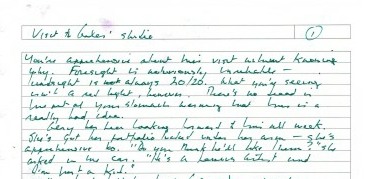From the mid-1980s to the end of the ’90s I was variously involved in local theater, as stage manager, actor, and lead theater reviewer for one of the two local weeklies. (No, I never reviewed a show I was involved in.) What I learned during those years continues to affect my writing to this day. Here are some of the ways.
Of all the things I’ve ever written, one of my most favorites is a monologue: “The Assistant Stage Manager Addresses Her Broom After a Performance of Macbeth.” Guess where that came from? It’s all in iambic pentameter, which isn’t all that hard to write when you’re living with Shakespeare day in, day out. I loved performing it and did so “off book,” meaning from memory, without a script. (See “R Is for Readings” for more about giving readings.)
During that period I also wrote three one-act plays, all of which were produced at least once. Spend enough time around theater and it may become one of the languages you speak. I haven’t attempted any plays since, in part because the once-vital local theater scene dwindled and in part because I went on to other things. But my theater experience continues to affect how I write.
When writing fiction, I often feel as though I’m watching the scene play out onstage. Early in a play’s rehearsal period, one of the stage manager’s most important jobs is to record the director’s instructions to the actors in what becomes the prompt script. This includes not only the entire text of dialogue and stage directions but how the actors move on the stage and all the light, sound, and music cues. For the rest of the rehearsal period it’s the ultimate arbiter of what cast and crew are supposed to be doing — until the director makes changes, of course.
How the actors move onstage is called blocking — and that’s exactly what I often do when writing a scene. I’m both the director giving directions and the stage manager writing it all down. My characters are my actors. I watch them, prompt them, and sometimes even become them. I also listen to them, because often they tell me what I need to know.
One benefit of this is that it keeps my attention on what my characters are doing, and how they look doing it, as well as what they are saying. In my writers’ group, a common comment when dialogue goes on too long uninterrupted is “More body language!” Characters reveal themselves in what they do and how they move as well as what they say.
What they say (or don’t say) is crucial too, of course, and theater is an ongoing master class in dialogue. Sometimes a reader will complain that a stretch of dialogue goes on too long. To this I respond that full-length plays are virtually all dialogue. We can be riveted for two hours by people talking. As I wrote some years ago in a blog post “Monologue About Dialogue,” the challenge is to create dialogue that’s not only realistic but riveting — “dialogue that develops characters, moves the plot along, and gives the reader a break from one narrative paragraph after another.” You can learn plenty about this from both reading plays and watching them performed.
Sometimes dialogue does go on too long. Theater experience comes in handy here too. Imagine the dialogue being played out onstage. Would you be riveted, or would you start fidgeting, flip through your program, or even think of walking out? Novelist-screenwriter Thomas McGuane called the lengthy, un-riveting sort of writing “dead air,” and he drew on theater and his screenwriting experience to get the point across: “After you’ve written screenplays for a while, you’re not as willing to leave these warm-ups in there, those pencil sharpenings and refillings of the whiskey glasses and those sorts of trivialities. You’re more conscious of dead time. Playwrights are even tougher on themselves in this regard. Twenty mediocre pages hardly hurt even a short novel but ten dead minutes will insure that a play won’t get out of New Haven.”
A poet I once workshopped with called this dead time “soft ice”: it doesn’t bear weight. You’ll probably have plenty of dead air and soft ice in your early drafts. In revising, you recognize it and either punch it up or throw it out.
Finally, one more lesson from my involvement in community theater: Less is (often) more. Local actors in the late 20th century were lucky to have as a dialect and accents coach the late Dr. Louise Gurren, a retired professor of linguistics who’d been an avid theater buff all her life. When we actors were cast as a character who was southern or English or Russian or Australian, we went to her to learn how to sound the part. Her method went like this: First she’d teach the accent as authentically as possible. Once we had that down, she’d point out that if we spoke that way, the audience would have a hard time understanding what we were saying. So she’d then teach us to “back off” enough so that we sounded authentic but were still comprehensible to a general audience.
Excruciating accuracy is a must if you’re conducting an experiment or reporting a news story, but on the stage and in fiction it can get in the way. Conveying a character’s accent, dialect, or use of slang can become parody if overdone, and parody can come across as insulting. So try taking Dr. Gurren’s advice: write as authentically as possible the first time around, then back off enough that the accent, dialect, or slang doesn’t call attention to itself.


 By Katrina Otuonye
By Katrina Otuonye